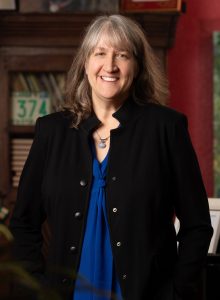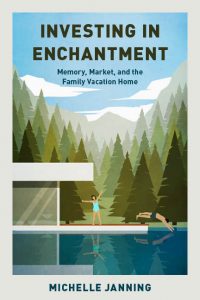Michelle Janning has been writing about the intersections of family life and spatial and material culture for more than two decades. She has published numerous books and articles about the sociology of homes, social research methods in architecture and design, love letters as family story memory objects, and material and spatial dimensions of family relationships and life stage transitions. Janning is a frequent public speaker, consultant on projects that intersect sociology and design worlds, and community-engaged sociologist. Her work has appeared in prominent media publications including The New York Times, The Atlantic, Cosmopolitan, Real Simple, and NPR. Here I ask her about her latest book, Investing in Enchantment: Memory, Market, and the Family Vacation Home, which is a qualitative multi-method and multi-year study on family vacation homes. Her research, writing, and public-facing work is elaborated on her website.
AMW: In your book, you don’t necessarily use fixed formal government classifications such as “investment property” and “vacation home” to examine family vacation home properties. How did you make this decision and what methods did you use to figure this out?
MJ: I examine the perceptions and practices of homeowners who use their vacation homes for personal family use, who rent their homes to others, or both. As I started to talk with people about their second properties in the early stages of my research, I realized that the formal classifications of properties based on taxes, zoning, mortgages, and governmental definitions based on homeowner occupancy were useful, but were definitely not how people actually used or attached meaning to their homes. Formal classifications don’t uncover subjective meanings that may vary based on time, social context, and family circumstances. That’s why my project is qualitative, took place over several years, and contains attitudes and behaviors from lots of different kinds of stakeholders involved with the family vacation home industry: five years’ worth of homeowner interviews, ethnographic research at hospitality and vacation rental conferences, media analysis of vacation home real estate shows and newspaper articles from amenity-rich locations, and examination of expert advice for families wondering if they should rent their vacation homes to other families.
AMW: How do family vacation homes defined with your classifications — used by families, rented to others, or a bit of both — tell the story of what’s actually going on with families today?
MJ: The homes featured in my book were not only hard to classify because sometimes people didn’t want to classify them (to save money on taxes, for example, or to not have to report a property as an investment property in any official way); they were also hard to classify because their use and definition changed, even for the families themselves. During the time frame of my research, some families were actually in the process of deciding whether to increase the amount of time they were renting out their vacation home because it wasn’t being used by family members as much as they had hoped. Some were shifting the use of an investment property to be a vacation spot for their family to use more often. Some were using portions of their primary residence to rent out as a vacation spot for other people. Some rented their vacation homes to families once or twice and then switched to long-term rental, or the other way around. Others had no idea what the legal or taxation classifications were supposed to be for a property, since they had inherited the property from parents or even grandparents and other family members managed the financial aspects of the property. And still other elements of my research shifted because people changed how they used their homes (and other people’s homes) for leisure and paid work during COVID-19 lockdowns.
So, that Airbnb cabin your family rented for vacation? That counts in my research. That family cabin you’re considering listing on Airbnb (or at least charging a cleaning fee to friends who stay there) but don’t want it classified as an investment property? That counts. And the cabin you cannot bring yourself to sell or rent to others because it contains so many treasured family memories, even though your kids and grandkids say they don’t want it? That definitely counts. Formal classifications can’t help us understand how the meaning of these homes may be socially constructed by families in response to contemporary patterns in the sharing economy, generational shifts in homeownership and geographic mobility, and highly variable regulatory practices at the local level.
My book tells the story of how vacation property ownership, location, and use may vary from family to family and person to person. But my findings also paint a picture about how family roles and relationships impact the story and point to many shifting family patterns in the United States: increasing geographic mobility among younger generations, generational shifts in beliefs about whether family spaces should be used to make money, a desire to create memorable family moments for people on vacation, changing work and family roles during marriage, and reconsidering of family rituals in light of changing life stages. Add to this the highly variable ways that neighborhoods and communities respond to any kind of family vacation homes, and it becomes clear that time, geography, and familial context make formal property classifications insufficient if we want to understand property use and meaning.
AMW: Why is the word “enchantment” in your book title? Is this about fairy tales?
MJ: Despite some group differences related especially to controversies in communities about short-term vacation rental regulations, the three property groups — those who used family vacation homes for their own families, to rent to others, or some combination of both — really had more in common with each other than not. The findings pointed to a central finding: family vacation homes are supposed to be magical places removed from the harsh worlds of markets, inequalities, and community controversies. In fact, they are also supposed to be removed from stresses of everyday life in a family’s primary home.
Family vacation homes are enchanted. Maybe even fairy tale-like. Enchantment, or more accurately disenchantment, is a concept that has filled the minds and writings of sociological thinkers since Max Weber elevated it within the social sciences as Entzauberung, a word that translates from German to English as “de-magicization.” I have stumbled upon two seemingly contradictory things about how people think about family when it comes to vacation homes. First, home is still supposed to be a location where romance, magic, and fairy tale-like expectations about families are alive and well. At the same time, people know the fairy tale is not real when it comes to their everyday family lives that take place in their homes. They understand that there is no such thing as enchantment when capitalism governs all social life. Homes are locations where violence, trauma, and pain are present. People across many walks of life have increasingly recognized that home lives are not necessarily enchanted havens from a stressful world, because they carry their own stresses, a realization made especially clear during the COVID-19 pandemic amid housing and economic crises that disproportionately affect low-income families and families of color who cannot afford to buy or keep a home.
But, despite being actual homes and containing actual families, family vacation homes are framed differently by homeowners and other stakeholders in the family vacation home industry. They are magical, rising above the realities of everyday family lives in primary homes. Despite the fact that they are places where families gather, they are part of the deeply entrenched cultural story of the romanticization of American family life, a romance with more and more revelation of the real hardships of contemporary family life. We succumb to the powerful cultural value of the enchantment of the family vacation home even as we increasingly realize that family life is far from a fairy tale. Family memories and nostalgia become social strategies meant to “enchant” the family vacation home as a magical place removed from both the marketplace and the headaches of everyday work, family, and politics. They are a bastion of (sometimes artificial) relief from stress that is not just about our paid work lives, it is also stress related to our home lives. This is especially vivid when homeowners reframe the labor attached to maintaining a vacation home as leisure. If it is to be a magical place for one’s own family or for other families, it is not supposed to reveal hardships that threaten the fairy tale.
Why does this happen? It’s often about nostalgia. The word “memory” is also in my book title. As a result of the precarity of family continuity (including a squeeze for enough time to spend together in the hectic calendar of daily life), ritualized family events and special occasions—and their accompanying photographic and material souvenirs—are more prominent than ever. Family vacation homes feature prominently in these kinds of projects. To create treasured moments for the family requires joy. Happiness comes from turning family stress and labor into clear success stories and mementos to signify that success. To have priceless family memories is to personalize the experience out of love, to make it all magical. Thus, the family must be enchanted in order to preserve its story and to protect it from the harsh and impersonal realities of labor and the marketplace. But, of course, it takes work (and often purchases) to create this kind of joy. So, investing in projects meant to make memories that younger generations will look back upon with fondness is a means to enchantment. People have turned to vacation homes to create a physical repository of shared memories of generations that are increasingly geographically dispersed and busy with the daily grind of moving from home to work and back home again. Family vacation homes require people to pause, create memories, and retain the magic. But all of this requires participation in the real estate marketplace, which of course is not a very enchanted place to be. And someone has to wash the dirty bedding. So families mask the money and labor matters and focus on the memories instead. That classification of memories as priceless, by the way, can make some family members have a hard time wanting to sell the family cabin.
This brings me to shifts in the marketplace. Airbnb, Vrbo, Vacasa, HomeToGo, and other similar online companies are vivid examples of new marketplaces that allow ordinary people to dabble in business ventures by renting out their primary or second residences or portions of them. Owners and renters serve as “co-creators” of value in the global travel service marketplace, since the economic exchange occurs between peers, not between a person and a company. This exchange is part of a rise in what sociologist Juliet Schor terms “connected consumption,” often referred to as the sharing or gig economy. For families that opt to rent out their homes to other vacationing families, the focus on the money-making aspect runs counter to enchantment. Family memories are meant to be priceless, after all. For this reason, the vacation rental industry is rife with advice on how to redefine a space meant for making money into a place for family memories. That the memories are for someone else’s family is downplayed in order to lift up the cultural value of family vacation home spaces as enchanted for any family.
Alicia M. Walker is Associate Professor of Sociology at Missouri State University and the author of two previous books on infidelity. She is the current editor of the Council of Contemporary Families blog and serves as Senior Fellow with CCF. Learn more about her on her website. Follow her on Twitter at @AliciaMWalker1 and Instagram @aliciamwalkerphd



Comments